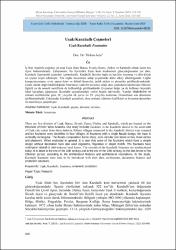| dc.contributor.author | Acar, Türkan | |
| dc.date.accessioned | 2021-08-09T11:03:14Z | |
| dc.date.available | 2021-08-09T11:03:14Z | |
| dc.date.issued | 2019 | en_US |
| dc.identifier.citation | Acar, T . (2019). Uşak/Karahallı Çeşmeleri . Afyon Kocatepe Üniversitesi Sosyal Bilimler Dergisi , 21 (2) , 419-436 . DOI: 10.32709/akusosbil.445232 | en_US |
| dc.identifier.uri | https://dergipark.org.tr/tr/pub/akusosbil/issue/45362/445232 | |
| dc.identifier.uri | https://hdl.handle.net/11630/9046 | |
| dc.description.abstract | İç Batı Anadolu eşiğinde yer alan Uşak ilinin Banaz, Sivaslı, Eşme, Ulubey ve Karahallı olmak üzere beş
ilçesi bulunmaktadır. Çalışmamız, bu ilçelerden Uşak kent merkezinin güneydoğusunda yer alan,
Karahallı ilçesindeki çeşmeleri içermektedir. Karahallı ilçesine bağlı on beş köy taranmış ve dört köyde
on çeşme tespit edilmiştir. Tek cephe tasarımına sahip çeşmelerde kütle dikey dikdörtgendir. Cephe
kompozisyonunu, sivri, yarım daire ve dilimli kemerler, taslık nişleri ve plasterler şekillendirmektedir.
Genel olarak değerlendirildiğinde bezemesiz sade bir tasarıma sahip olan çeşmelerin bazılarında bitkisel,
figürlü ya da nesneli motiflerin de kullanıldığı görülmektedir. Çeşmeler doğal ya da kullanıcı kaynaklı
lokal kayıplara uğramıştır. Karahallı çeşmelerinden yedisi bugün işlevsizdir. Yapılar kitabelerine ve
mimari özelliklerine göre 18. yüzyılın ilk yarısı ile 19. yüzyılın sonlarına, Osmanlının son dönemine
tarihlenmektedir. Çalışmada, Karahallı çeşmeleri, plan, mimari, süsleme özellikleri ve korunma durumları
ile tanıtılmaya çalışılmıştır. | en_US |
| dc.description.abstract | There are five districts of Uşak, Banaz, Sivaslı, Eşme, Ulubey and Karahallı, which are located on the
threshold of Inner West Anatolia. Our study includes fountains in the Karahallı district in the south-east
of Uşak city center from these districts. Fifteen villages connected to the Karahallı district were scanned
and ten fountains were identified in four villages. In fountains with a single facade design, the mass is
vertically rectangular. The facade composition forms sharp, semi-circular and sliced arches, bowl niches
and plasterers. When evaluated in general, it is seen that some of the fountains which have a simple
design without decoration have also used vegetative, figurative or object motifs. The fountains have
undergone natural or user-induced local losses. The seventh of the Karahallı fountains are dysfunctional
today. It is dated to the end of the 18th century and to the end of the 19th century, to the last period of the
Ottoman period, according to the architectural features and architectural inscriptions. In the study,
Karahallı fountains were tried to be introduced with their plan, architecture, decoration features and
protection situations. | en_US |
| dc.language.iso | tur | en_US |
| dc.publisher | Afyon Kocatepe Üniversitesi | en_US |
| dc.identifier.doi | 10.32709/akusosbil.445232 | en_US |
| dc.rights | info:eu-repo/semantics/openAccess | en_US |
| dc.subject | Uşak | en_US |
| dc.subject | Karahallı | en_US |
| dc.subject | Çeşme | en_US |
| dc.subject | Süsleme | en_US |
| dc.subject | Koruma | en_US |
| dc.title | Uşak/Karahallı çeşmeleri | en_US |
| dc.title.alternative | Uşak/Karahallı fountains | en_US |
| dc.type | article | en_US |
| dc.relation.journal | Afyon Kocatepe Üniversitesi Sosyal Bilimler Dergisi | en_US |
| dc.department | Seçiniz | en_US |
| dc.authorid | 0000-0003-4357-8411 | en_US |
| dc.identifier.volume | 21 | en_US |
| dc.identifier.startpage | 419 | en_US |
| dc.identifier.endpage | 436 | en_US |
| dc.identifier.issue | 2 | en_US |
| dc.relation.publicationcategory | Makale - Ulusal Hakemli Dergi - Başka Kurum Yazarı | en_US |



















